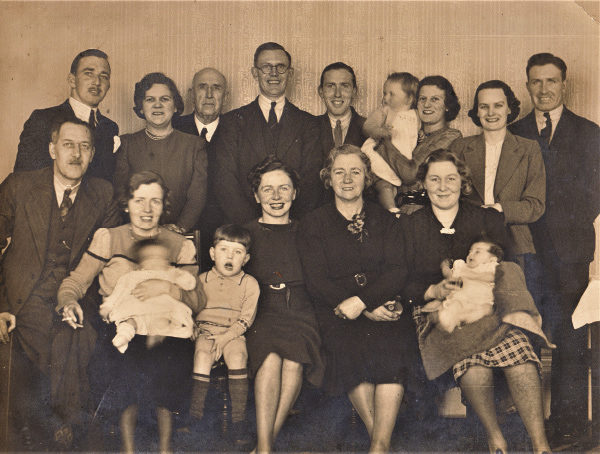
Aplin family photo with Edgar back row, third from left
By Geneva Pattison
Pigeon House Road was once home to a Mr. Edgar Aplin. He was a chemist by trade with a passion for all things musical. The historical Gresham Hotel seemed like an appropriate setting to interview his granddaughters about their grandfather’s surprising story.
A pre-spring chill was in the air, but the spirits of the fans watching the rugby on TV in the lounge were anything but frosty. Unfortunately for us, this meant shouting was necessary over the devoted legion of sports enthusiasts. A lively start indeed.
Edgar started out life in a surprising manner, as there was an element of mystery surrounding his birth. Speaking to his granddaughters Hilary and Stephanie, they elaborated on this statement.
Hilary discovered him in the 1901 census while researching their family history: “If you go to the census, you’ll find it says he was born in England… he wasn’t”. They already knew this to be false, due to family lore. Aplin was, in fact, born either on a steam boat in transit to South America, or in South America itself.
Edgar’s father had found work in South America as a silversmith or “whitesmith” as the ladies explain, so he and his wife packed up and shipped out. Hilary and Stephanie remember family stories about Edgar’s childhood, revolving around him spending his first few years sleeping in a drawer, “there were no cots back then!”.
Edgar returned to Ireland when he was seven years old from a non-English speaking continent having had no formal education. His granddaughters believe he must have been a dedicated student with academic talent, because when he was older he pursued pharmaceutical studies. Stephanie recalls a foolproof recipe passed down to her that originated from Edgar’s treatment for chronic hiccups: “A teaspoon of sugar, soaked in white vinegar and swallowed whole. I swear to God, I’ve never found anything so good”. Similarly, she was told of a concoction he made on site for burns using carron oil. It was hailed by the Dublin 4 locals and potentially developed specifically to cater for injuries coming from the nearby Glass Bottle works.
You’re probably wondering by now, what makes him a singing chemist?
His granddaughter Stephanie explains that her mother told her stories about her grandfather Edgar’s love of music: “My mother used to say that my granny and grandad went to the Theatre Royal, for an evening and during the interval the audience used to call for Aplin’s song, because he had a beautiful voice… he used to get up on stage and entertain them!”
Sadly, neither granddaughter can recall what exact song was ‘Aplin’s song’, although, Hilary believes it would have been similar to the songs of Jimmy O’Dea and Maureen Potter, as they were popular at the time. Stephanie went into further detail about Edgar’s musicality, “the family were all very musical, they could sing and play instruments”. “They were in a playgroup” says Hilary, “and they used to travel around to different churches performing”.
Finding the exact address of Edgar’s pharmacy in Ringsend proved difficult as his granddaughters were unsure of the location. After some digging through the Pearse Street Archives, Stephanie and I discovered the addresses of his premises and his years of activity as a pharmacist. His first pharmacy was located at 2, Bayview Irishtown from 1912 to the early 1930’s. After this he was stationed at 16 Bridge Street Ringsend, till his retirement in 1942.
He began to lose his hearing in the early 40’s, which was somewhat detrimental to his career. “Chemists in those days were like doctors… it would have been very dangerous if he’d lost his hearing,” says Hilary. They needed fully functioning senses, as he was constantly diagnosing conditions. He was the public’s first port of call when they were sick. As a musical man, hearing loss must have been tough but, his granddaughters remember him having an old ear trumpet, which would have provided some relief.
It must have been a difficult time for Edgar Aplin, as in 1941, as his son Capt. Thomas Aplin fell victim to an unbelievably strange misfortune. His ship, the City of Waterford, collided with another vessel, the Dutch Tug Thames in the Atlantic Ocean. Capt. Thomas Aplin led his crew safely to the lifeboats and launched them into the sea. They were rescued by the HMS Deptford and watched as their ship, City of Waterford, slowly submerged to the deep.
However, they did not remain safe for very long. Shortly after their rescue, they were transferred to another rescue ship, the Walmer Castle, which was then brutally bombed with few survivors. Edgar’s son, Captain Thomas perished in the attack. Stephanie kindly provided the original newspaper cutting from the 1941 tragedy.
Hilary’s search for information on her ancestors led her to contact a distant cousin, who had dug up some interesting accounts of their family history. He had found out that they were also related to a man called Robertus Aplin born in 1588, who “attended Charles I on the scaffold at Whitehall Palace in 1649 and to whom the King gave one of his gloves before he was executed”. It was a big deal in the 17th century to receive anything from the King, let alone be in his presence.
Hilary and Stephanie would be interested to hear from any readers who might remember Edgar Aplin or his pharmacy. If you remember anything about him or have any photos of his Pharmacy, please contact NewsFour.



